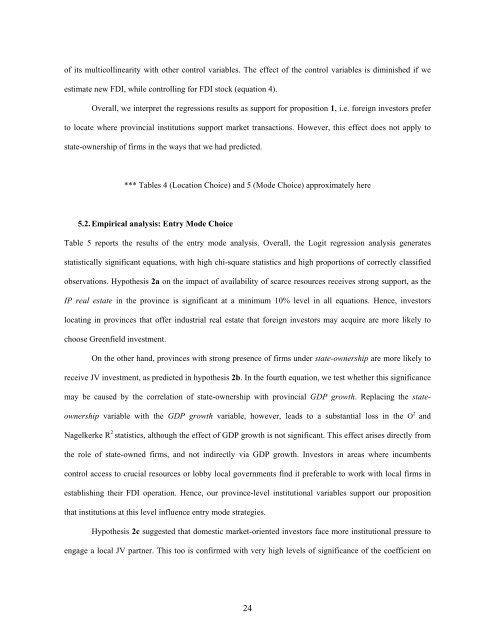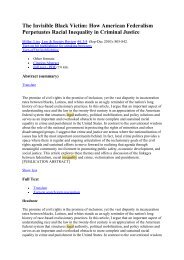Foreign Investment Strategies and Sub-national ... - E-Journal
Foreign Investment Strategies and Sub-national ... - E-Journal
Foreign Investment Strategies and Sub-national ... - E-Journal
Create successful ePaper yourself
Turn your PDF publications into a flip-book with our unique Google optimized e-Paper software.
of its multicollinearity with other control variables. The effect of the control variables is diminished if we<br />
estimate new FDI, while controlling for FDI stock (equation 4).<br />
Overall, we interpret the regressions results as support for proposition 1, i.e. foreign investors prefer<br />
to locate where provincial institutions support market transactions. However, this effect does not apply to<br />
state-ownership of firms in the ways that we had predicted.<br />
*** Tables 4 (Location Choice) <strong>and</strong> 5 (Mode Choice) approximately here<br />
5.2. Empirical analysis: Entry Mode Choice<br />
Table 5 reports the results of the entry mode analysis. Overall, the Logit regression analysis generates<br />
statistically significant equations, with high chi-square statistics <strong>and</strong> high proportions of correctly classified<br />
observations. Hypothesis 2a on the impact of availability of scarce resources receives strong support, as the<br />
IP real estate in the province is significant at a minimum 10% level in all equations. Hence, investors<br />
locating in provinces that offer industrial real estate that foreign investors may acquire are more likely to<br />
choose Greenfield investment.<br />
On the other h<strong>and</strong>, provinces with strong presence of firms under state-ownership are more likely to<br />
receive JV investment, as predicted in hypothesis 2b. In the fourth equation, we test whether this significance<br />
may be caused by the correlation of state-ownership with provincial GDP growth. Replacing the state-<br />
ownership variable with the GDP growth variable, however, leads to a substantial loss in the Ο 2 <strong>and</strong><br />
Nagelkerke R 2 statistics, although the effect of GDP growth is not significant. This effect arises directly from<br />
the role of state-owned firms, <strong>and</strong> not indirectly via GDP growth. Investors in areas where incumbents<br />
control access to crucial resources or lobby local governments find it preferable to work with local firms in<br />
establishing their FDI operation. Hence, our province-level institutional variables support our proposition<br />
that institutions at this level influence entry mode strategies.<br />
Hypothesis 2c suggested that domestic market-oriented investors face more institutional pressure to<br />
engage a local JV partner. This too is confirmed with very high levels of significance of the coefficient on<br />
24














